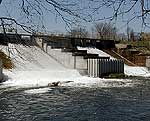By Tom Robertson
Minnesota Public Radio
May 29, 2002
Since the late 1800s, the U.S. Army Corps of Engineers has built six dams on Mississippi River lakes in northern Minnesota. The original purpose was to control water flow for downstream navigation. Now, the dams are used mostly to control flooding and maintain lake levels. It's been almost 50 years since the Corps examined the effectiveness of the system. Now a major study is underway. The Corps hopes to broaden the study to include other dams on headwaters lakes.
| |
|
|
|
||
The Reservoir Operating Plan Evaluation, or ROPE study, comes after several years of high water levels on the headwaters lakes. Unprecedented rainfall and a long-term rise in the groundwater table caused lakeshore flooding and erosion.
Ed McNally, project manager for the Army Corps of Engineers, says the goal of the study is to find the best way to manage the waters - in the best interests of the environment and the people who live there.
"We have not done a re-analysis of the way we operate our dams for now over 40 years," says McNally. "There's a lot that's happened in that 40 years in the headwaters reservoirs. If you look at the growth in the area...there's a lot of development that's occurred around the lakes."
McNally says there have been many times in the past where dams have released water, and the people downstream have been caught by surprise.
"If you release water downstream, there is a trade-off upstream and downstream, and effects system-wide," he says. "And so there is going to be a need to look at more than an individual structure. You have to look at all of the structures and how they interrelate."
Part of the problem is, not all dams in the Mississippi chain of lakes are controlled solely by the Corps of Engineers. There's one on Cass Lake operated by the U.S. Forest Service. The DNR controls the Mud Lake Dam. And there's a dam on Prairie Lake run by Minnesota Power.
The hydroelectric dam east of Lake Bemidji was built in 1907 by the Otter Tail Power Co. No longer an important source of electricity, its role now is to maintain lake levels upstream. The company is mandated to keep water at a certain level. During wet periods, the dam has to release more water downstream to avoid flooding on Lake Bemidji.
| |
|
|
|
||
Jack Frost, a Beltrami County commissioner and member of the Mississippi Headwaters Board, owns a resort on Lake Andrusia, downstream from the power dam. He says he's caught in the middle of dam systems that haven't always worked together.
"There are buildings that were built at my resort in the '20s and '30s that now have water in the basements - that are going to have to be rebuilt, because the water is just higher," Frost says. "And there have been instances where the lake levels can go up eight to 10 inches overnight. And that has serious impacts on water quality and vegetation and the habitat and such."
Some flooding may have been beyond the scope of human control. But some say lakeshore damage could have been lessened if the dams had been managed better.
"The headwaters area should be managed as a system," says Jane VanHunnick, director of the Mississippi Headwaters Board. "If the Corps is able to put together a model that would predict the results of various decisions that would be made with respect to reservoirs, it would be helpful. Because then we would be able to make a determination as to what impacts, positive or negative, would be had along shorelines, which would affect resort owners, recreation - all the natural scientific values that we uphold," she says.
The ROPE study project is running into funding problems. The Army Corps will pay about $2.5 million to study the six reservoirs under its control. Studying the rest of the dams will cost another $400,000. It's not yet clear where that money will come from.
Project managers say there will be additional costs later on. They say the study is likely to conclude that some of the dams will need major structural improvements. Those costs could range from $4 million to $20 million. The study is expected to take about four years.
More Information

